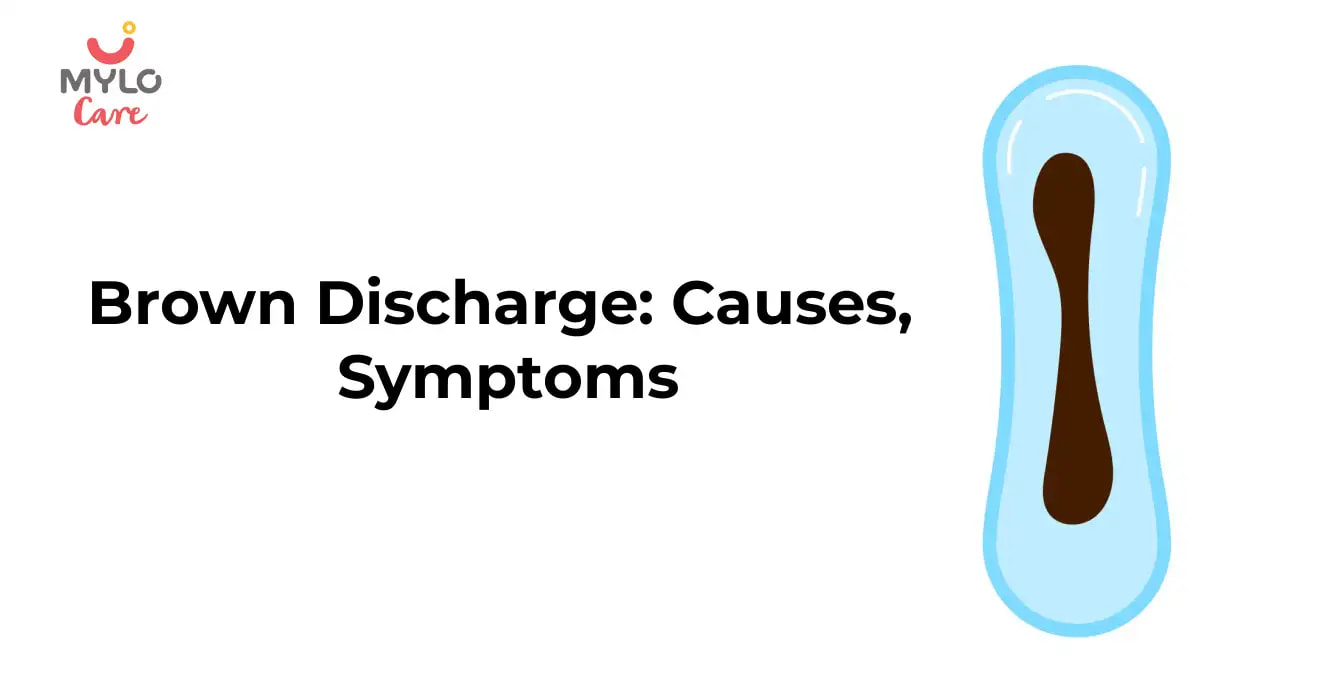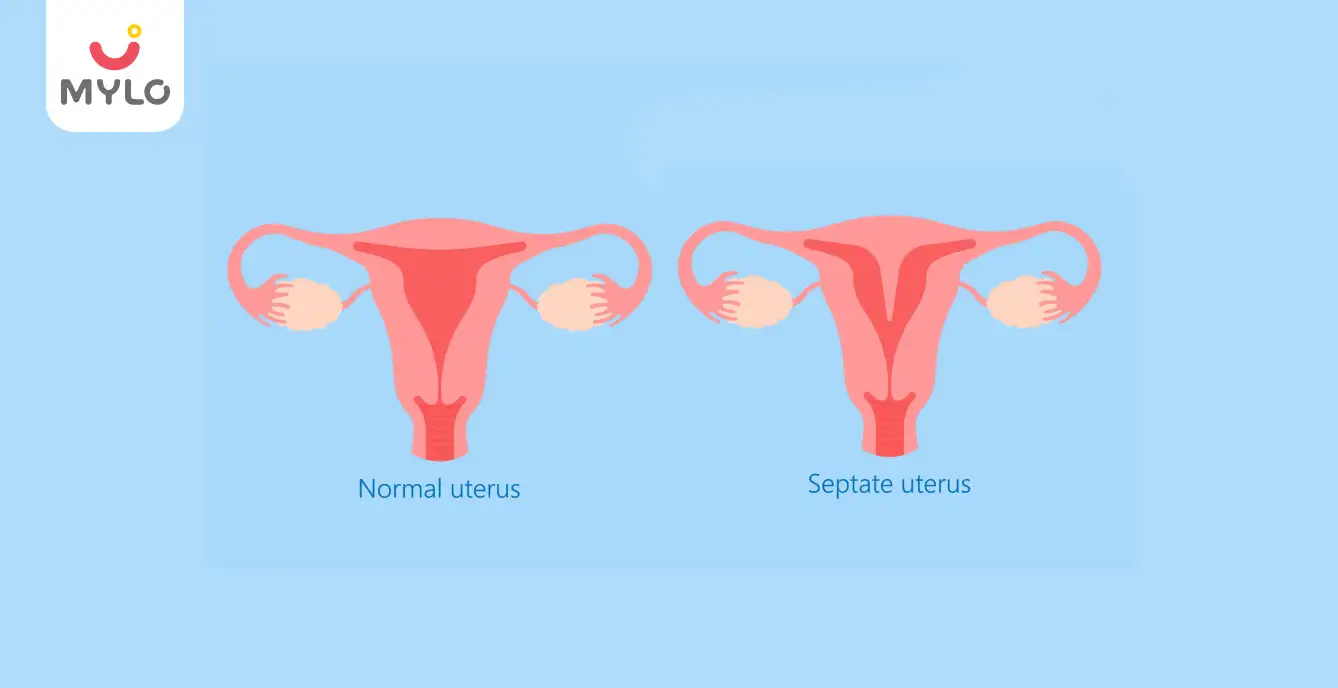Home

Brown Discharge: Causes, Symptoms and When to Seek Help
In this Article

Pregnancy
Brown Discharge: Causes, Symptoms and When to Seek Help
Updated on 8 January 2024
Have you ever experienced that moment of panic when you notice something unusual happening with your body? We all have those moments, and one of the most common causes of concern for many women is brown discharge. It's not a topic we often discuss openly, but it's important to shed some light on it. In this article, we'll dive into the causes, symptoms, and when to seek help if you're experiencing such a discharge.
What is brown vaginal discharge?
Brown vaginal discharge is a common occurrence among women and can have different causes. It is typically a result of older blood mixing with vaginal discharge, giving it a brownish hue.
The color can vary from light brown to dark brown, and the consistency may range from watery to thick. While it is generally not a cause for concern, understanding the potential causes and associated symptoms is important for women's health.
Is brown discharge a sign of pregnancy?
One of the most common questions women have is whether brown discharge is a sign of pregnancy. Brown discharge before period can be an early sign of pregnancy, it is not a definitive indicator on its own.
Implantation bleeding, which occurs when a fertilized egg attaches to the uterine lining, can cause brown discharge. However, other factors such as hormonal changes, infections, or irregularities in the menstrual cycle can also lead to brown discharge.
You may also like: Yellow Discharge Before Period: Is It Normal or a Cause for Concern?
10 reasons for brown discharge
Let us now understand the potential causes of brown discharge:
1. Implantation bleeding
During early pregnancy, implantation of the fertilized egg can cause brown vaginal discharge.
2. Hormonal changes
Fluctuations in hormone levels, particularly estrogen and progesterone, can result in brown colour discharge.
3. Menstrual cycle irregularities
Brown discharge after period or before period can also occur due to variations in the menstrual cycle.
4. Perimenopause
As women approach menopause, hormonal changes can cause also cause discharge with a brown colour.
5. Cervical polyps
These noncancerous growths on the cervix can lead to brown discharge.
6. Vaginal infections
Infections such as bacterial vaginosis or yeast infections can cause brown colour discharge along with other symptoms like itching or odor.
7. Sexually transmitted infections
Certain sexually transmitted infections like gonorrhea or chlamydia can cause brown hued discharge.
8. Pelvic inflammatory disease
This infection of the reproductive organs can result in brown vaginal discharge.
9. Endometrial hyperplasia
Thickening of the uterine lining, often caused by hormonal imbalances, can lead to discharge brown in colour.
10. Cervical or uterine cancer
While rare, cancer can be a cause of brown discharge. It is important to rule out this possibility through medical evaluation.
Is brown discharge before period normal?
Experiencing brown discharge before a period is relatively common and is often not a cause for concern. It can be a sign that older blood is being expelled from the uterus before the menstrual flow starts. However, if the brown discharge is accompanied by severe pain, foul odor, or lasts for an extended period, it is advisable to consult a healthcare professional to rule out any underlying conditions.
Is brown discharge after period normal?
Brown discharge after a period can also be considered normal in many cases. It is often a result of the uterus expelling the remaining blood and tissue from the previous menstrual cycle. However, if the discharge is accompanied by itching, discomfort, or persists for an unusually long time, it is important to seek medical advice to ensure there are no underlying infections or other health issues.
How common is brown discharge during ovulation?
Brown discharge during ovulation is not uncommon. It can occur due to hormonal changes and the release of a mature egg from the ovary. Some women may experience light spotting or brown discharge during this time. However, if the discharge is accompanied by severe pain, heavy bleeding, or other concerning symptoms, it is recommended to consult a healthcare provider.
You may also like: Brown Discharge & Early Pregnancy: Understanding the Causes & Next Steps
When to see a doctor for brown discharge?
While brown discharge is often harmless, there are certain instances when it is advisable to seek medical help:
1. Persistent or prolonged discharge
If the brown discharge lasts for an extended period or occurs frequently, it is important to consult a healthcare professional.
2. Foul odor or itching
If the discharge is accompanied by a foul odor or itching, it may be a sign of an infection and medical attention should be sought.
3. Abnormal bleeding
Heavy bleeding, blood clots, or brown discharge that is significantly different from the usual menstrual flow should be evaluated by a doctor.
4. Severe pain
If the brown discharge is accompanied by severe pelvic pain or cramping, it is important to seek medical advice.
5. Unusual symptoms
Any other unusual symptoms or concerns should be discussed with a healthcare provider to ensure appropriate evaluation and treatment.
Final Thoughts
While brown discharge is often a normal occurrence, it is important to pay attention to any changes in color, consistency, or associated symptoms. Understanding the potential reasons for brown discharge and knowing when to seek medical help can help ensure women's health and well-being. If in doubt, it is always best to consult a healthcare professional for an accurate diagnosis and appropriate guidance.



Written by
Anandita Sharma
Drawing on more than a decade of expertise in administration, Anandita Sharma currently serves as a content operations e
Read MoreGet baby's diet chart, and growth tips

Related Articles
Related Questions
Hello frnds..still no pain...doctor said head fix nhi hua hai..bt vagina me pain hai aur back pain bhi... anyone having same issues??

Kon kon c chije aisi hai jo pregnancy mei gas acidity jalan karti hain... Koi btayega plz bcz mujhe aksar khane ke baad hi samagh aata hai ki is chij se gas acidity jalan ho gyi hai. Please share your knowledge

I am 13 week pregnancy. Anyone having Storione-xt tablet. It better to have morning or night ???

Hlo to be moms....i hv a query...in my 9.5 wk i feel body joint pain like in ankle, knee, wrist, shoulder, toes....pain intensity is high...i cnt sleep....what should i do pls help....cn i cosult my doc.

Influenza and boostrix injection kisiko laga hai kya 8 month pregnancy me and q lagta hai ye plz reply me

RECENTLY PUBLISHED ARTICLES
our most recent articles

Care for Baby
Baby Hair Style: A Complete Guide for Trendy Parents

Ovulation
Breast Pain During Ovulation: A Comprehensive Guide on Causes and Solutions

Scans & Tests
PCOS Ultrasound: What to Expect During the Procedure

Women Specific Issues
Uterus Didelphys: Understanding Symptoms, Risks and Treatment Options

Women Specific Issues
Septate Uterus: A Comprehensive Guide on Symptoms, Risks, and Treatment Options

Vaccinations
Should Pregnant Women Get Flu Shots
- Why you should choose a Vaginal Delivery? Know the pros & cons
- The Art of Painting When Pregnant: Tips for a Safe and Creative Experience
- Do Pregnant Women Get Their Period?
- A Guide to Precautions After Ovulation When Trying to Conceive
- Tight Vagina and Women's Health: An In-Depth Guide
- The Ultimate Guide to Using Olive Oil for Baby Massage
- Heat Rash During Pregnancy: Causes, Symptoms and Prevention
- The Ultimate Guide to Understanding the Reasons for Late Period
- What Can Be the Maximum Delay in Periods If Not Pregnant?
- Black Period Blood: Is It Normal or a Cause for Concern?
- Lean PCOS: A Comprehensive Guide on Causes, Symptoms and Treatment
- PCOS Mood Swings: The Ultimate Guide to Causes and Strategies for Relief
- PCOS and Thyroid: Understanding the Complex Relationship and Finding Solutions
- Intermittent Fasting & PCOS: The Ultimate Guide to Benefits, Risks and Precautions


AWARDS AND RECOGNITION

Mylo wins Forbes D2C Disruptor award

Mylo wins The Economic Times Promising Brands 2022
AS SEEN IN
















- Mylo Care: Effective and science-backed personal care and wellness solutions for a joyful you.
- Mylo Baby: Science-backed, gentle and effective personal care & hygiene range for your little one.
- Mylo Community: Trusted and empathetic community of 10mn+ parents and experts.
Product Categories
baby carrier | baby soap | baby wipes | stretch marks cream | baby cream | baby shampoo | baby massage oil | baby hair oil | stretch marks oil | baby body wash | baby powder | baby lotion | diaper rash cream | newborn diapers | teether | baby kajal | baby diapers | cloth diapers |








